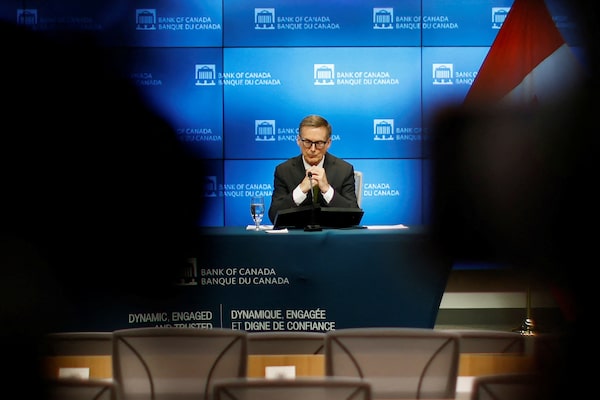
Bank of Canada Governor Tiff Macklem takes part in a news conference after announcing an interest rate decision in Ottawa, Ont. on March 6.Blair Gable/Reuters
Jeremy Kronick is vice-president of economic analysis and strategy and director of the Centre on Financial and Monetary Policy at the C.D. Howe Institute, where Steve Ambler, a professor of economics at Université du Québec à Montréal, is the David Dodge Chair in Monetary Policy.
The inflation beast is looking considerably weaker. Between the Bank of Canada’s rate announcement on Sept. 4 and its announcement on Wednesday, Statistics Canada released two of its monthly reports on the consumer price index. They showed that headline inflation fell by almost a full percentage point and is now well below target.
For this reason, markets were not surprised by the 50-basis point cut in the Bank of Canada’s overnight rate target. The cut was fully baked into market expectations, and there was even speculation about a supersized cut of 75 basis points.
As it is, the bank has more work to do with its overnight rate. With inflation falling faster than the policy rate, monetary policy in real terms has become more restrictive since the summer. When the bank cut the overnight rate to 4.25 per cent at its last meeting, inflation was at 2.5 per cent, meaning the real policy rate (adjusted for inflation) was 1.75 per cent. With inflation falling to 1.6 per cent, even at an overnight rate now of 3.75 per cent, the real policy rate, at 2.15 per cent, is actually a bit tighter.
Below-target inflation combined with Canada’s relatively weak economy suggests that the overnight rate target should already be at least at the “neutral rate,” the sweet spot that neither restricts nor stimulates economic growth. The Bank of Canada currently estimates the neutral rate to be in the range of 2.25 per cent to 3.25 per cent.
So, why aren’t we already there? Why did the bank not cut by an even more supersized 100 basis points to get us to 3.25 per cent? (A basis point is one-hundredth of a percentage point.)
One of the major factors pushing down headline inflation is gasoline prices (down 10.7 per cent over the past year) and, more generally, energy prices (down 8.3 per cent over the past year). However, there are strong geopolitical risks both in the Middle East and Ukraine, which could suddenly push world oil prices up and lead to a spike in inflation.
Rob Carrick: Not-so-smart things people do with their money when interest rates fall
Next, prices for services, growing at 4 per cent over the past year, are pushing overall inflation higher. This upward pressure will continue for some time, with domestic wages growing at 4.6 per cent year-over-year in September. Productivity growth would help us absorb these wage increases without stoking inflation, but, alas, our record on that front is weak.
Lastly, core inflation, which strips away the more volatile components of the consumer price index and gives an indication of where inflation is headed in the medium term, remains elevated. The bank’s preferred measures, so-called CPI-Trim and CPI-Median, are both still above the 2 per cent target and falling only slowly.
Despite these upside risks, the downside risks to inflation are also substantial, and in our view, more so.
The mortgage interest cost component of inflation is still very high, at 16.7 per cent year-over-year in September. Stripping out mortgage interest costs, inflation has been at or below target since the beginning of the year. Moreover, because mortgage interest costs are largely driven by the Bank of Canada’s policy rate itself, it will continue to cool rapidly as the policy rate decreases, putting less upward pressure on headline inflation.
Next, while services inflation has been high, goods prices have fallen by 1 per cent over the past year.
And, lastly, money growth, whether in bank accounts or cash, for example, remains well below the averages we saw pre-COVID – a sign of weakening demand.
The bank’s Monetary Policy Report in April had forecast headline inflation to return to target only in the second half of 2025. Wednesday’s updated Monetary Policy Report now forecasts inflation to remain close to target. The fact that we are there already suggests that the bank needs to loosen monetary policy at a faster pace.
On balance, with the overnight rate where it is, inflation is more likely to remain low or even decrease.
The overnight rate is now within striking distance of the neutral rate. Two cuts of 25 basis points in December and January or one more large 50-basis point cut in December will put us there. While upside risks remain, there is just too much data suggestive of a weak economy and inflation set to continue to fall if monetary policy remains overly restrictive. The bank should get the overnight rate back to neutral earlier rather than later.